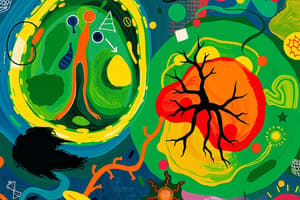Podcast
Questions and Answers
What is diffusion?
What is diffusion?
Diffusion is the process by which particles, molecules, or other substances spread through space because of random motion.
How does diffusion reflect the statistical nature of particle movement?
How does diffusion reflect the statistical nature of particle movement?
Diffusion reflects the statistical nature of particle movement as individual entities exhibit unpredictable trajectories due to continuous collisions with surrounding molecules.
What is the connection between diffusion and random walks?
What is the connection between diffusion and random walks?
Random walks are a mathematical model used to describe the random and successive steps taken by a particle in a particular direction, mirroring the stochastic nature of particle movement in diffusion.
How do random walks illustrate the nature of particle movement in diffusion?
How do random walks illustrate the nature of particle movement in diffusion?
What is the critical interplay between diffusion and random walks?
What is the critical interplay between diffusion and random walks?
What is bacterial chemotaxis?
What is bacterial chemotaxis?
What is the function of special sensors on bacteria in chemotaxis?
What is the function of special sensors on bacteria in chemotaxis?
How does diffusion relate to the spread of chemicals in solutions?
How does diffusion relate to the spread of chemicals in solutions?
What is the role of randomness in shaping dynamic processes?
What is the role of randomness in shaping dynamic processes?
How do random walks model particle movement?
How do random walks model particle movement?
What is the significance of diffusion in scientific disciplines?
What is the significance of diffusion in scientific disciplines?
What phenomenon does diffusion lead to at a macroscopic level?
What phenomenon does diffusion lead to at a macroscopic level?
What are the key components involved in bacterial chemotaxis?
What are the key components involved in bacterial chemotaxis?
How do bacteria navigate chemical gradients using flagella?
How do bacteria navigate chemical gradients using flagella?
What is the role of G protein-coupled receptors (GPCRs) in eukaryotic chemotaxis?
What is the role of G protein-coupled receptors (GPCRs) in eukaryotic chemotaxis?
What are the differences in chemotaxis mechanisms between bacterial and eukaryotic cells?
What are the differences in chemotaxis mechanisms between bacterial and eukaryotic cells?
What fundamental principles do bacterial and eukaryotic cells share in chemotaxis?
What fundamental principles do bacterial and eukaryotic cells share in chemotaxis?
What is the significance of reaction-diffusion systems in biological processes?
What is the significance of reaction-diffusion systems in biological processes?
How do reaction-diffusion mechanisms contribute to embryonic development?
How do reaction-diffusion mechanisms contribute to embryonic development?
Why are mathematical modeling and simulation crucial in unraveling complex biological processes?
Why are mathematical modeling and simulation crucial in unraveling complex biological processes?
In what ways do reaction-diffusion models contribute to understanding cell spatial organization during development?
In what ways do reaction-diffusion models contribute to understanding cell spatial organization during development?
How do mathematical models assist in deciphering regulatory mechanisms ensuring stability and functionality in complex biological processes?
How do mathematical models assist in deciphering regulatory mechanisms ensuring stability and functionality in complex biological processes?
What is the role of mathematical models in contributing to our understanding of biological systems?
What is the role of mathematical models in contributing to our understanding of biological systems?
How do mathematical models aid in the study of tissue differentiation and morphogen gradients?
How do mathematical models aid in the study of tissue differentiation and morphogen gradients?
Study Notes
Cellular Chemotaxis and Reaction-Diffusion Mechanisms
- Bacterial chemotaxis involves sensing gradients triggering protein changes and phosphorylation cascades influencing the rotation direction of the flagellar motor.
- Bacteria spin flagella one way in response to attractants (e.g., nutrients) and the other way for repellents, enabling precise navigation in chemical gradients.
- Eukaryotic chemotaxis involves G protein-coupled receptors (GPCRs) recognizing external signals and activating intracellular signaling pathways, leading to actin cytoskeleton reorganization for directional cell movement.
- Both bacterial and eukaryotic cells exhibit different chemotaxis mechanisms, with bacteria using transmembrane receptors and a phosphorelay system, while eukaryotic chemotaxis primarily involves GPCRs and complex signaling pathways.
- Despite differing mechanisms, both bacterial and eukaryotic cells share fundamental principles in chemotaxis, relying on receptor-mediated sensing of chemical gradients and coordinating actin dynamics in eukaryotic cells or modulating flagellar motors in bacterial cells.
- The interplay of self-activation, inhibition, and diffusion, described by reaction-diffusion systems, is pivotal for generating intricate spatio-temporal patterns across various biological scales.
- Reaction-diffusion mechanisms contribute to crucial spatial patterns in embryonic development, as seen in the Turing model influencing limb digit segmentation, and in the immune system's regulation through diffusible signaling molecules like cytokines.
- Mathematical modeling and simulation are crucial tools for unraveling complex biological processes, exemplified in phenomena like chemotaxis and multicellular pattern formation.
- Mathematical models, often in the form of equations, illuminate the dynamics of cellular movement, signaling pathways, and environmental gradients in chemotaxis, aiding in interpreting experimental data and identifying key factors influencing biological behaviors.
- Reaction-diffusion models reveal how local interactions and signaling molecule diffusion shape cell spatial organization during development, and simulations enable the study of complex pattern emergence, such as tissue differentiation or morphogen gradients.
- Mathematical models serve as a quantitative framework for hypothesis testing, prediction, and experimental guidance, contributing to our understanding of the robustness and adaptability of biological systems.
- Through simulations, researchers explore parameter spaces and conduct sensitivity analyses, identifying conditions crucial for specific biological outcomes, critical for deciphering regulatory mechanisms ensuring stability and functionality in complex biological processes.
Studying That Suits You
Use AI to generate personalized quizzes and flashcards to suit your learning preferences.
Related Documents
Description
Test your knowledge of cellular chemotaxis and reaction-diffusion mechanisms with this quiz. Explore the intricate signaling pathways and mechanisms involved in bacterial and eukaryotic chemotaxis, as well as the role of reaction-diffusion systems in generating spatial patterns in biological processes. Delve into mathematical modeling and simulation as essential tools for understanding complex cellular behaviors and pattern formation.




